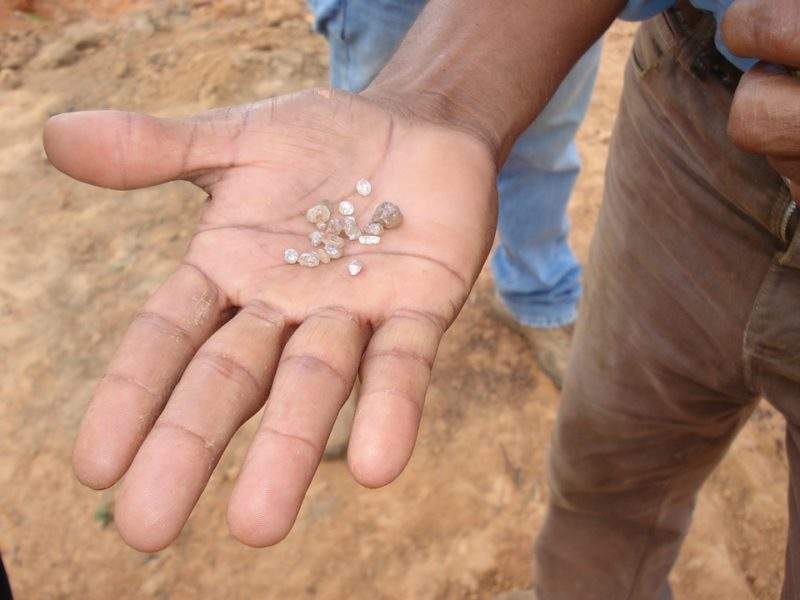
With a range of extractive processes, an imbalanced global supply chain and the legacy of conflict diamonds affecting stability and production in West Africa, we consider the processes and consequences of how diamonds are mined.
How are diamonds mined?
The extractive industry employs a range of techniques for mining diamonds, starting with conventional open-pit operations. The world’s largest mine, the Debswana-owned Orapa project in Botswana, uses open-pit mining to extract diamonds located up to 250m below the surface. In 2015, the mine extracted over 9.6 million carats, and its owners aim to extend operations to 450m below ground, further extending the project.
The Jubilee mine in Sakha, Russia, uses an extraction method known as pipe mining. This involves embedding shanks into long cylinders of kimberlite ore, known as ‘pipes’, and digging up large amounts of soil. This soil is then transported off-site, where it is processed at specialised facilities to separate rough diamonds from the majority of the soil. The operations have been effective, as Jubilee is Russia’s largest mine with a production of 9 million carats in 2015 from estimated reserves of 125.4 million carats.
The Mir project, also located in Russia, is the world’s second-largest excavation ever drilled, and has used a combination of open-pit and underground mining methods. Diamonds were originally extracted using the former method, with production at the 525m deep mine starting in the 1950s, and reaching ten million carats of diamond a year within a decade.
However, open-pit operations were closed in 2001 following accidents and an admission by the mine’s owners, Sakha, that the diamond reserves had been exhausted, but the mine was shifted to an underground-only operation. In 2017, current owners Alrosa announced that Mir was producing diamonds worth $400m annually, the maximum capacity of the project.
One of the largest single diamonds ever extracted, the Millennium Star, was unearthed using a third method: alluvial mining. This process takes place in kimberlite deposits that are washed away from pipes before they can be mined by water below the Earth’s surface. This water transports the ore to beaches and oceans, enabling a secondary extraction process to take place. Typically, companies wall off bodies of water or divert rivers, creating dried out areas where the alluvial deposits can be extracted.
The Millennium Star is the largest diamond recovered from the Mbuji-Mayi operations in the Democratic Republic of Congo (DRC), which has estimated reserves of 158 million carats.
Global supply chain
These vast Russian operations contributed to the country’s 42 million carats produced in 2017, the most in the world, according to the Kimberley Process Certification Scheme (KPCS), figures collected by the Kimberley Process, an international organisation that works to remove conflict diamonds from the global diamond trade.
While countries such as Canada and Australia featured highly on the ranking in terms of production – with totals of 23 million carats and 17 million carats respectively – none of these countries saw their diamonds reach prices of more than $100 per carat. Australian diamonds were particularly undervalued, with the country’s exports totalling $200m, equivalent to $11.7 per carat.
Conversely, African countries saw significantly greater returns on their exports. Botswana, third only to Russia and Canada in total production with 22.9 million carats, saw an average export price of $145 per carat, and total sales of £3.3bn, second to Russia.
Countries with lower annual production figures saw even more impressive prices, with Namibia’s 1.9 million carats generating an average price of $518.7 per carat, and Sierra Leone’s 289,000 carats generating $423 per carat.
African nations are also not importing diamonds on the scale of other countries around the world. World’s Top Exports reported in 2014 that the US was responsible for 18.4% of all diamond imports, followed by Hong Kong at 16.4% and India at 16.1%. With Botswana the only African country in the top 15, responsible for just 2% of diamond imports, the figures depict a relatively one-sided international relationship, with diamonds mined in African countries, and exported to other continents.
While this pattern is encouraging for economic growth in nations with highly-valued diamonds, countries such as Australia are struggling to capitalise on an industry with high demand.
Australia’s largest diamond mine, the Rio Tinto-owned Argyle operation, has seen its ore reserve plummet from 29 million tonnes in 2016 to 16 million tonnes the following year, a 45% drop that threatens to undermine diamond production in Australia and beyond. Business Insider Australia writer Chris Pash expects the closure of Argyle to reduce global diamond production by 10%, and argued that this will “create upward pressure on prices”.
Conflict diamonds
In several countries, the diamond industry raises ethical, rather than economic, concerns. Conflict diamonds – defined by the Kimberley Process as “rough diamonds used to finance wars against governments” – have historically been exported from Angola, the DRC, Liberia and Sierra Leone.
The Ivory Coast was the last country to see significant production of conflict diamonds. The country’s two civil wars (from 2002 to 2007 and from 2010 to 2011), saw diamond mines in the north fall to revel forces, and it is alleged that conflict diamonds were used to fund conflicts that killed over 3,000 people in the second civil war alone.
In 2004, the UN placed a decade-long embargo on Ivorian diamonds, and the country’s diamond exports fell to zero, according to the Kimberley Process.
However, since the ban was repealed in 2014, the country’s diamond industry has flourished; the Ivory Coast produced 1,074 carats of diamonds in 2014, compared to 7,360 in 2017.
The Kimberley Process also claims that the proportion of conflict diamonds in the international market is 0.2%, compared to around 20% during the Sierra Leone civil war, which took place from 1991 to 2002, and with 81 governments incorporating the KPCS into law, there is hope that the global diamond industry will continue to eliminate conflict diamonds.



